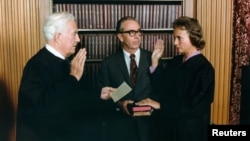Sandra Day O’Connor, who in 1981 became the first woman appointed to the U.S. Supreme Court, died Friday at her home in Arizona. She was 93.
In a release, the Supreme Court said O’Connor died from “complications related to advanced dementia, probably Alzheimer’s, and a respiratory illness.”
In 2018, O’Connor released a letter saying she had been diagnosed with “the beginning stages of dementia,” suspecting it was Alzheimer’s disease. She announced at that time she was withdrawing from public life.
In a statement, U.S. Supreme Court Chief Justice John Roberts called O’Connor “a fiercely independent defender of the rule of law.” He added, “Sandra Day O’Connor blazed a historic trail as our Nation’s first female Justice. She met that challenge with undaunted determination, indisputable ability, and engaging candor. We at the Supreme Court mourn the loss of a beloved colleague.”
O’Connor was born in El Paso, Texas, March 26, 1930. She married John Jay O’Connor III in 1952. She received her undergraduate and law degrees from Stanford University.
She served as Deputy County Attorney of San Mateo County, California, from 1952 to 1953. From 1958 to 1960, she practiced law in Maryvale, Arizona, before serving as Assistant Attorney General of Arizona from 1965 to 1969.
She was appointed to the Arizona State Senate in 1969 and was subsequently reelected to two two-year terms, during which she was selected as Majority Leader.
In 1975, she was elected Judge of the Maricopa County Superior Court and served until 1979, when she was appointed to the Arizona Court of Appeals. She served there until her nomination to the U.S. Supreme Court.
Though appointed by the conservative late President Ronald Reagan, O’Connor became known as a centrist during her 24-year-term, casting the deciding vote on a number of key controversial issues, including votes upholding abortion, and affirmative action.
She sided with the court’s conservatives in 2000, however, casting the deciding vote in the 5-4 decision in the Bush v. Gore case that ultimately decided the presidential election in favor of Republican George Bush over Democratic candidate Al Gore.
Upon her retirement in 2006, Bush nominated Samuel Alito to replace her, the man who would eventually write the decision to overturn Roe v. Wade, the decision which made abortion a legal right nationally.
O’Connor is survived by three sons, six grandchildren and her brother, Alan Day Sr. Her husband, John O’Connor, died in 2009.
Some information for this story was provided by The Associated Press and Reuters.

